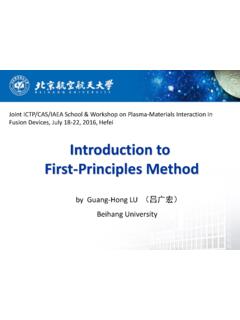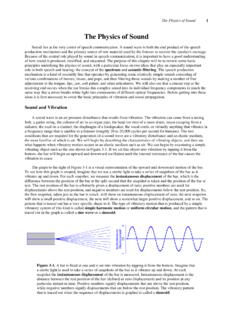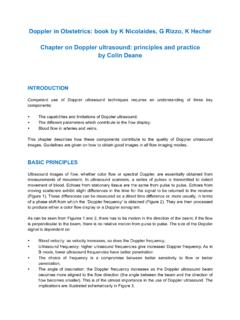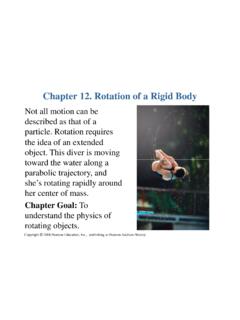Transcription of Mark Scheme (Results) January 2014 - Edexcel
1 Mark Scheme (Results) January 2014 International GCSE physics (4PH0) Paper 1P Science Double Award (4SC0) Paper 1P Edexcel Level 1/Level 2 Certificates physics (KPH0) Paper 1P Science (Double Award) (KSC0) Paper 1P Edexcel and BTEC Qualifications Edexcel and BTEC qualifications are awarded by Pearson, the UK s largest awarding body. We provide a wide range of qualifications including academic, vocational, occupational and specific programmes for employers. For further information visit our qualifications websites at or Alternatively, you can get in touch with us using the details on our contact us page at Pearson: helping people progress, everywhere Pearson aspires to be the world s leading learning company.
2 Our aim is to help everyone progress in their lives through education. We believe in every kind of learning, for all kinds of people, wherever they are in the world. We ve been involved in education for over 150 years, and by working across 70 countries, in 100 languages, we have built an international reputation for our commitment to high standards and raising achievement through innovation in education. Find out more about how we can help you and your students at: January 2014 Publications Code UG037848 All the material in this publication is copyright Pearson Education Ltd 2014 General Marking Guidance All candidates must receive the same treatment.
3 Examiners must mark the first candidate in exactly the same way as they mark the last. Mark schemes should be applied positively. Candidates must be rewarded for what they have shown they can do rather than penalised for omissions. Examiners should mark according to the mark Scheme not according to their perception of where the grade boundaries may lie. There is no ceiling on achievement. All marks on the mark Scheme should be used appropriately. All the marks on the mark Scheme are designed to be awarded. Examiners should always award full marks if deserved, if the answer matches the mark Scheme .
4 Examiners should also be prepared to award zero marks if the candidate s response is not worthy of credit according to the mark Scheme . Where some judgement is required, mark schemes will provide the principles by which marks will be awarded and exemplification may be limited. When examiners are in doubt regarding the application of the mark Scheme to a candidate s response, the team leader must be consulted. Crossed out work should be marked UNLESS the candidate has replaced it with an alternative response. Question number Answer Notes Marks 1 (a) C (the walls) no marks for air is trapped as is given in stem conduction/convection mechanism described air can t convect up through layers allow air is trapped fibres prevent movement of air 1 (b) D (40%) 1 (c) (i) Any two of Fibres are good insulators / bad conductors; Air is a bad conductor / good insulator; Because air particles are widely spaced; conduction requires solids/does not occur in gases.
5 2 (ii) stopping /reducing (formation of) convection currents; air in the insulation can t move/eq; 2 Total 6 marks Question number Answer Notes Marks 2 (a) MP1. Ray reflects correctly (by eye, any ray straight down the page (allow +/- 10 ), ignore horizontal displacement); MP2. Normal shown / construction line between actor and image; MP3. Reflected ray projecting back to image; not spread out from 1 point for MP1 3 2 (b) any one from: cannot be formed on a screen/eq ; rays do not actually come from there ; rays {diverge/don t actually cross} after reflection; image formed by extension (backwards) of light rays ignore what is seen in a mirror not real properties of image in mirror, inverted, same distance 1 MP1MP2MP3 (c) (i) Any suitable example.
6 Sound, ultrasound, deep water waves Allow seismic (P-) waves, waves in a (slinky) spring 1 (ii) vibrations/oscillations are parallel or perpendicular; To direction of energy transfer/ direction of travel; Correct identification of both types; allow vibrations up and down for perpendicular vibrations back and forward for parallel Accept suitably labelled diagrams a correct description of either wave = 2 marks Transverse: Longitudinal: ignore: examples of either type of waves if no other mark, accept descriptions of pressure changes or clear diagram(s) showing compression and rarefaction for 1 mark only 3 Total 8 marks Total 8 marksQuestion number Answer Notes Marks 3 (a) (i) power = voltage x current.
7 Accept rearrangements and symbols current = power voltage, P=IV, I=P/V ignore a triangle mnemonic an eqn in units 1 (ii) (A); Accept (A), (A) 1 (b) (i) Any three of : MP1. if current gets too high/exceeds 13A or a set value; MP2. fuse (wire) melts / breaks; MP3. breaking circuit / switching off; MP4. prevents cable over heating; allow: fuse blows stops current /flow of electrons 3 (ii) any one of: MP1. cable can t be fully extended; MP2. limits the use of the extension cable; MP3. can t exceed 1200 W; MP4. can t reach (A) / max working value/eq; AND (because otherwise) 5 A fuse will blow/ will cut the power; allow RA ignore vague comments re energy or power being too much or too high 2 (iii) (to prevent) the cable overheating/OWTTE; 1 Question number Answer Notes Marks 4 (a) Position of poles indicated correctly near end of magnet; S on L AND N on R ; Allow at the end of the magnet within or either end 2 (b) Any suitable method, Place plotting compass at side/end of magnet.
8 Mark position of end of compass; Move end of compass needle to new mark (and repeat); OR o Place magnet under paper / plastic; o Sprinkle iron filings over; o Tap paper gently (to reveal pattern); allow suitably clear diagram(s) reject for one mark charges ignore comments about finding the direction of the field allow: steel dust for iron filings place for sprinkle 3 Total 5 marks Question number Answer Notes Marks 5 (a) (i) starting height (of the toy car); 1 (ii) a positive correlation between the 2 key variables, eg The higher the (starting) height, the faster the (final) speed / speed at bottom; NB response needs to mention both key variables 1 (b) use a ruler or a set square ; further detail; held vertically check for zero error thickness of board taken into account avoid parallax errors Allow suitably labelled diagram drawn in the space below perpendicular to bench 2 Question number Answer Notes Marks 5 (c) (i) any one of the following ideas.
9 O speed might have increased / changed on slope o car might have accelerated o other forces could be acting hence (she has) calculated the average speed; accept slowed down ignore timing errors 2 (ii) any three from: MP1. Suitable equipment / method chosen; MP2. Detail of measuring the distance; MP3. Detail of measuring the time; MP4. Detail of experimental set-up; MP5. Speed at bottom = 2 x total distance total time (assuming constant acceleration from rest) / idea of doubling; allow MP5 independent of other marks Acceptable approaches, - Light gate and data logger computer; Placed at end of ramp; With interrupter of some description on toy car; OR Attach ticker tape to car; Find the part of the tape that matches end of the ramp; Work out distance over time for a small section; OR Film with video camera; With scale marked in background; Measure from frame by frame playback; OR motion sensor(near bottom of ramp); facing up the ramp.
10 Readings taken at the bottom; Max 3 Question number Answer Notes Marks 5 (d) Any three of timing variation; distance variation /accuracy of starting position; friction effect; poor launch ; Acceptable ideas include- error from starting / stopping stopclock / effect of reaction time (IGNORE human error ) car not running straight/ramp not even effect of (rolling) friction effect of air resistance/drag friction not constant car pushed at start car hits side of ramp ignore different car/changing slope height Max 3 Total 12 marks Question number Answer Notes Marks 6 (a) MP1.













